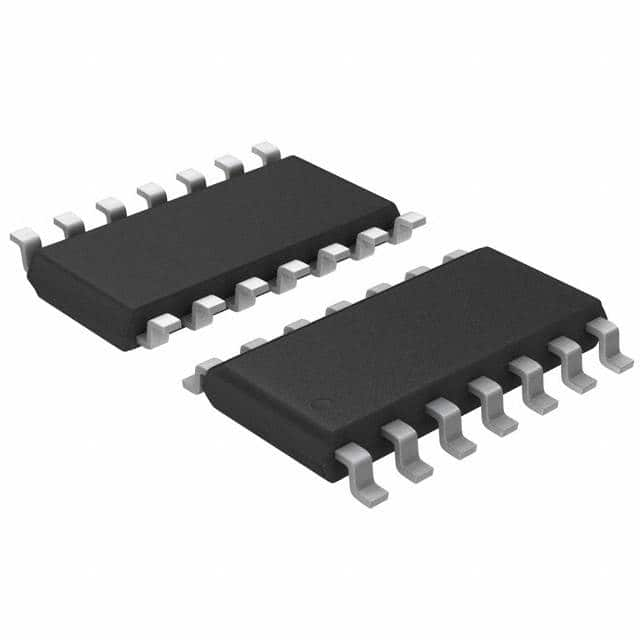Xem thông số kỹ thuật để biết chi tiết sản phẩm.

Encyclopedia Entry: 74VHC126MTR
Product Overview
Category
The 74VHC126MTR belongs to the category of integrated circuits (ICs).
Use
This IC is commonly used in digital logic applications for signal buffering and level shifting.
Characteristics
- High-speed operation
- Low power consumption
- Wide operating voltage range
- Compatibility with various logic families
- Schmitt-trigger inputs for noise immunity
Package
The 74VHC126MTR is available in a small outline transistor (SOT) package.
Essence
This IC is an advanced high-speed CMOS buffer with 3-state outputs, designed to provide efficient signal amplification and level conversion.
Packaging/Quantity
The 74VHC126MTR is typically packaged in reels containing a specified quantity of units, such as 2500 pieces per reel.
Specifications
- Supply Voltage Range: 2.0V to 5.5V
- Input Voltage Range: 0V to VCC
- Output Voltage Range: 0V to VCC
- Maximum Operating Frequency: 200MHz
- Propagation Delay Time: 4.5ns (typical)
- Output Current: ±8mA
Detailed Pin Configuration
The 74VHC126MTR has a total of 14 pins, which are assigned specific functions as follows:
- Pin 1: 3-State Output Enable (OE)
- Pin 2: Input A
- Pin 3: Input B
- Pin 4: GND (Ground)
- Pin 5: Output Y1
- Pin 6: Output Y2
- Pin 7: VCC (Supply Voltage)
- Pin 8: Output Y3
- Pin 9: Output Y4
- Pin 10: Input C
- Pin 11: Input D
- Pin 12: GND (Ground)
- Pin 13: 3-State Output Enable (OE)
- Pin 14: VCC (Supply Voltage)
Functional Features
- 3-state outputs allow for high impedance when disabled, enabling multiple devices to share a common bus.
- Schmitt-trigger inputs provide hysteresis and improve noise immunity.
- High-speed operation allows for efficient signal amplification and level shifting.
- Wide operating voltage range makes it compatible with various logic families.
Advantages and Disadvantages
Advantages
- High-speed operation enables fast data transmission.
- Low power consumption results in energy-efficient performance.
- Compatibility with different logic families provides flexibility in circuit design.
- Schmitt-trigger inputs enhance noise immunity, ensuring reliable signal processing.
Disadvantages
- Limited output current may restrict its use in certain applications requiring higher drive capabilities.
- Propagation delay time may affect timing-sensitive circuits.
Working Principles
The 74VHC126MTR operates based on complementary metal-oxide-semiconductor (CMOS) technology. It utilizes a combination of MOSFETs (Metal-Oxide-Semiconductor Field-Effect Transistors) to amplify and buffer digital signals. The 3-state outputs allow the IC to control the flow of data on a shared bus, while the Schmitt-trigger inputs ensure stable and accurate signal detection.
Detailed Application Field Plans
The 74VHC126MTR finds application in various digital systems, including but not limited to: - Microcontrollers - Data communication interfaces - Memory modules - Industrial automation equipment - Automotive electronics
Detailed and Complete Alternative Models
- SN74LVC126A: Similar functionality with lower power consumption.
- MC74VHC126: Equivalent performance with different package options.
- CD74HCT126: Compatible with higher voltage levels.
These alternative models offer similar features and can be used as substitutes for the 74VHC126MTR, depending on specific requirements and availability.
In conclusion, the 74VHC126MTR is a high-speed CMOS buffer IC widely used in digital logic applications. Its key features include efficient signal amplification, level shifting, and compatibility with various logic families. While it offers advantages such as high-speed operation and low power consumption, limitations like limited output current should be considered. The IC finds application in diverse fields, and alternative models provide flexibility in circuit design.
Liệt kê 10 câu hỏi và câu trả lời thường gặp liên quan đến ứng dụng 74VHC126MTR trong giải pháp kỹ thuật
Sure! Here are 10 common questions and answers related to the application of 74VHC126MTR in technical solutions:
Question: What is the 74VHC126MTR?
Answer: The 74VHC126MTR is a quad buffer/line driver IC (integrated circuit) that can be used for signal buffering and level shifting applications.Question: What is the operating voltage range of the 74VHC126MTR?
Answer: The 74VHC126MTR operates within a voltage range of 2.0V to 5.5V.Question: How many buffers/drivers are there in the 74VHC126MTR?
Answer: The 74VHC126MTR has four independent buffer/drivers.Question: What is the maximum output current capability of the 74VHC126MTR?
Answer: The 74VHC126MTR can source or sink up to 8mA of current per output.Question: Can the 74VHC126MTR be used for bidirectional communication?
Answer: No, the 74VHC126MTR is unidirectional and can only be used for one-way signal transmission.Question: What is the typical propagation delay of the 74VHC126MTR?
Answer: The typical propagation delay of the 74VHC126MTR is around 4.5ns.Question: Is the 74VHC126MTR compatible with TTL (Transistor-Transistor Logic) inputs?
Answer: Yes, the 74VHC126MTR is fully compatible with TTL inputs.Question: Can the 74VHC126MTR tolerate overvoltage on its inputs?
Answer: No, the 74VHC126MTR is not designed to tolerate overvoltage on its inputs. It is recommended to use voltage level translators if interfacing with higher voltage signals.Question: What is the package type of the 74VHC126MTR?
Answer: The 74VHC126MTR comes in a TSSOP (Thin Shrink Small Outline Package) package.Question: Can the 74VHC126MTR be used in high-speed applications?
Answer: Yes, the 74VHC126MTR is suitable for high-speed applications due to its low propagation delay and high output drive capability.
Please note that these answers are general and may vary depending on specific datasheet specifications and application requirements.

